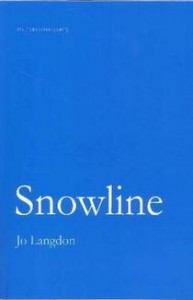Charles Manis reviews Snowline by Jo Langdon
Snowline
by Jo Langdon
Whitmore Press Poetry, 2012
ISBN 978 0 9757762 9 2
Reviewed by CHARLES MANIS
Snowline, the debut chapbook by Jo Langdon, is both elegant and powerful. The lyric poems in this volume operate primarily in couplets and tercets, and out of the white space come teeth and airplanes and fragments of narrative with the strategic force of well-timed jabs.
The sparseness of the page allows Langdon to bring home images that appeal to our senses in often surprising ways. In particular, Langdon has a knack for taking the common experience and presenting it in such fresh ways that it becomes visceral. Take, for example, the poem “Nausea,” in which the speaker recalls to the addressee:
Once, through the paper wall,
we heard your housemate’s skull collide
with toilet porcelain.
The wet barking of her sickness,
and then nothing.
(9)
In “Falling back to sleep,” the description of an experience so often rendered in terms of vision—light and darkness, clarity and haze—becomes voluminous:
This dream fills your mouth
like a sentence.
(10)
Between these moments of sensory arrival, Snowline glides. Few poems firmly establish narrative context, so even when Langdon treads into the familiar territory of the family poem, the approach is distinctly lyrical. The poem “After” never provides a family history, nor even any particular developed set of symbols that might stand in for a longer, firmer narrative. For that reason, the artifacts within the poem stand out much more: “an emptied coffee mug forgotten / on the verandah; a ring of sticky // whiskey on the bench”, and the box of matches, burned out and closed up, that concludes the poem (15). In “Dusk Street,” the speaker guides us like a sort of psychopomp from urban topography into a child’s dreams of “velveteen / ears” with an effortless transition that minds neither wall nor mode of experience (20). Similarly, a young girl in the final few lines of “Stratosphere” intercedes between the speaker and the addressee, shifting from a mid-air lightning strike to the ease of childish affections. Between poems, too, the transitions are fluid. “Shape” ends with light through a window transformed by bodily processes, and “Stratosphere” opens on the next page in a new location with, potentially, a new set of characters, but also with hands acting out their heat upon glass.
This lightness of movement is especially important in a collection of poems spoken almost exclusively from the first-person point of view. Almost every poem takes an extended experience (or set of experiences) and crystallizes it into a few concise lines. Even in a chapbook, a continuous series of first-person lyrics can become wearisome if not dealt with delicately. But Snowline manages the first-person lyric all the better through its disavowal of boundaries. Walls disappear, one consciousness enters another, and language makes space for its own shapes and value, as in “The Shape”:
Hands and wrists can be too intimate,
& I’m reminded of other words,
beautiful perhaps
for their vowel sounds
(love, moon, breath, pulse).
Tonight we’ll sleep on our sides
to watch the sky occupy
the bedroom window,
dimming away its stars to turn
a blue that belongs to ceiling shadows
or skyscrapers or gas-stove flames.
(5)
At its best, Snowline finds room for both the punchy, visceral image and for the ethereal play of light and shadow. And between these poles, the first-person speaker can move sometimes as what resembles a sort of spirit and sometimes as a fully embodied being. The collection is often preoccupied with images of flight that might fail at any time—planes threaten to crash, and birds fall dead. Yet, the poems often pull off their airiness with remarkable grace.
Many of these poems are spoken about or from within Vienna, and the whole of the collection has a somewhat European flavor. In “Stadtpark,” the speaker meets with her addressee surrounded by images of a Viennese spring, and the poem effectively conveys a sense of suspension, with its frozen scenery possible preceding a thaw. The speaker of these poems finds herself in an intermediary position, somewhere between tourism and familiarity. In the poem “In Wien,” the speaker notes:
These mountains don’t belong to my
horizons
(22)
Frequently, these moments of discomfort open the speaker and the reader to the unexpected. In “Little creatures,” a classroom lesson in French involving a dead sparrow gives way to another meditation on death and flight:
Il est mort? The boy asks, tilting his head
towards his mother’s.
The story is supposed to demonstrate
something French,
but instead we focus on this small thing
the sky can no longer hold.
(16)
“Little creatures,” though not necessarily set in a foreign country, brings with it multiple instances of that which is slightly alien and yet at the same time home-like, in the sense of the uncanny.
As a collection, Snowline reads like a constellation; its lyrics are held together by only the most delicate threads of light. At any time the poems seem they could drift apart. Yet, Langdon manages the elliptical, fragmentary, and sparse with incredible sensitivity. Even “Nausea,” perhaps my favorite poem in the chapbook, despite an image of skull striking porcelain demonstrates a lightness of touch that provides the reader enough space within familiar subject matter to see something new. Snowline, though littered with mouths, teeth, airplanes, machines, and metal, turns out a sort of ballet. Jo Langdon’s poetic balance and poise are striking in this debut volume.
Snowline was awarded the 2011 Whitmore Press Manuscript Prize.
CHARLES MANIS is a Philadelphia-based poet and he is currently pursuing a PhD in English Literature at Temple University. His work has recently appeared in RATTLE, Fifth Wednesday, and Spillway Magazine.
